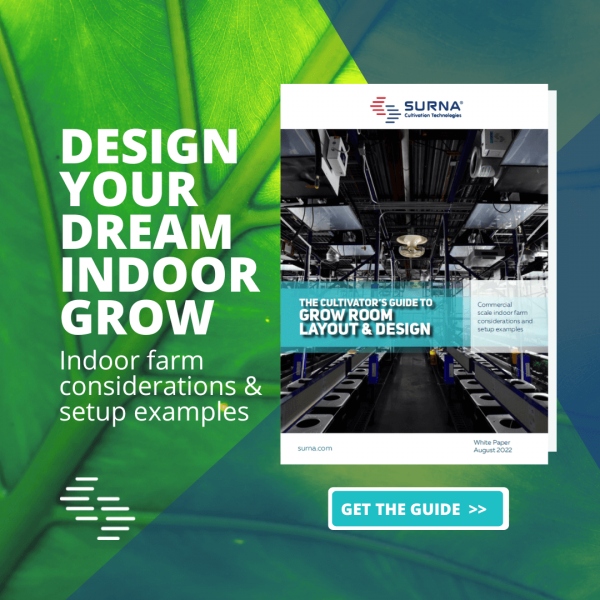Each month, we publish a newsletter discussing a trending topic within the cannabis industry and how it shapes Surna’s philosophy. To be one of the first to receive this information, be sure to sign up for our email list.
Missteps in a cultivation facility can lead to crop damage or loss amounting to hundreds of thousands of dollars. Luckily, these 5 tips can help you avoid the most common mistakes we see in cultivation facilities.
1. Improperly sized dehumidification
Dehumidification is often undersized because the amount of water entering a grow room is often not tracked. However, even in situations where dehumidification is properly sized for typical watering days, there is rarely enough dehumidification to account for flush days. During this time, when plants are flooded with water to remove excess nutrients, there can be 3-4 times as much water in a room than on a typical day.
Accounting for all sources of water in a room, and the maximum amount that will be introduced at a time, is critical to preventing powdery mildew and molds. A lack of dehumidification can lead to excess moisture hanging out in a room longer than desired, leading to potential crop loss.
2. Using an Incorrect Bulb Footprint
With the introduction of double-ended (DE) HPS bulbs, HPS lights became 30% more energy efficient. (Stop using single-ended (SE) HPS bulbs already!) With this additional light, it is possible to increase the light footprint of each bulb and decrease the overall number of lights needed. Designing a lighting layout for DE bulbs using SE footprints will lead to overlighting and overstressing plants and lowering yields.
To minimize this, check the recommended light footprint provided by the manufacturer and follow that recommendation. It is also important to check the footprint of the reflector. For example, the Surna Reflector is designed to be used on a 5’x5’ area instead of a 4’x4’ area. To verify that plants will receive enough light from the suggested layout, use a PAR meter to find out how many micromoles are reaching plants and use that information to determine how much the light count can be reduced.
3. Not Using Water Filtration
Filtering all water that is used on plants is incredibly important, especially when growing hydroponically. Mineral and chemical content of water can vary widely even within a single city. This makes it difficult to control exactly what a plant receives, and thus absorbs. Indoor cannabis growing is all about controlling every aspect of the grow, this should include the water the plants receive.
It is recommended to purify and sterilize all water before using it on plants. By doing so, any costly surprises associated with changes in the mineral content of the water being used will be avoided and you will always know exactly what minerals your cannabis plants are receiving and in what quantity.
4. Bringing in Fresh Air
Bringing in air from outside is a huge source of potential contamination and often causes more problems than it is worth. In order to decrease the chance of introducing mold, pests or pathogens into the grow room opt instead to purchase a properly sized cooling system for where you live and seal the grow room, eliminating the need to bring in outside air. Air sanitation should also be included in every room to further eliminate contamination risks.
In addition to being a source of contamination, outside air can wreak havoc on the carefully curated environment inside the grow room. If the air brought in from outside is not the same humidity level as that inside the grow room, large humidity swings can occur, and as point 1 stated, dehumidification systems are often not sized for the excess moisture.
5. Harvesting Early
As the saying goes, “Short-term gain equals long-term pain.” To achieve maximum yield from your cannabis plants, resist harvesting early, no matter how strong the temptation is. Letting the resin glands mature fully increases the quality of the end product, thus increasing the selling price.
That being said, make sure to keep a rigorous schedule for your overall facility. Every day a Flower Room sits empty is a day further from the next harvest. Creating a schedule for each room and sticking to it will allow the facility to run smoothly and maximize the number of harvests per year.

